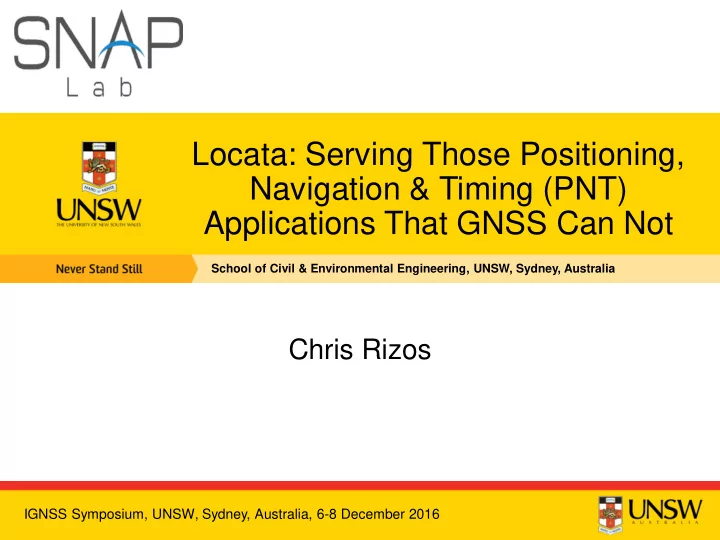

Locata: Serving Those Positioning, Navigation & Timing (PNT) Applications That GNSS Can Not School of Civil & Environmental Engineering, UNSW, Sydney, Australia Chris Rizos IGNSS Symposium, UNSW, Sydney, Australia, 6-8 December 2016
Introductory remarks… GNSS • U.S.’s GPS has been a fully operational GNSS since 1995 • Russia’s GLONASS system is fully operational • EU’s Galileo and China’s BeiDou are currently in deployment phases, nearing completion • Many economically valuable industries in Australia are reliant on augmented GNSS to deliver gains in productivity • Sophisticated DGNSS techniques can now deliver cm-level accuracy, in real-time, for precision navigation & guidance applications • There will be an expansion of applications that require Precise Positioning • GNSS cannot address PNT requirements in many environments where it is increasingly needed...
GPS visibility: Sydney 10deg elev, 7 December 2016 http://www.taroz.net/GNSS-Radar.html
GNSS visibility: Sydney 10deg elev, 7 December 2016 This is about 4x number used for standard GPS positioning... http://www.taroz.net/GNSS-Radar.html
“But... GNSS is like Swiss cheese… … it’s full of holes” Nunzio Gambale Locata Corp
Non-GNSS solutions? ... which one?! • There is no shortage of non-GNSS engineering options • Some technology options: • “signals-of-opportunity” • bespoke ranging systems • autonomous (non-signal) systems • Some are appropriate for mass market applications • Few can provide high accuracy PNT capability for pedestrian or vehicle applications • Locata is one such solution... considerable media interest
Locata components... • Signal Structure – Licence-free ISM frequency band (2.4GHz) – Dual-frequency carrier signals – CDMA PRN codes – Precise TDMA pulsing – >1 Watt output power - range of over 10’s km • LocataLite – Time-synchronised transceiver network – Dual Tx antennas – Uses low-cost clock, shared by receiver section – Network time is “relative” to master LL • Locata Receiver – CPH or PR single point-positioning – CPH requires ambiguity resolution – Real-time positioning at 10Hz
Locata deployments & tests ... over the last few years... • Static Deformation Monitoring • GNSS+Locata Open-Cut Mine Positioning • Static & kinematic Indoor/Outdoor Positioning • Multi-Sensor Positioning • Timing & Time Transfer
GNSS problem in ports... is multipath Terminal Automation Multipath (signals bouncing off metal) make GPS systems unusable for most of the automation applications in ports
The problem with RTK-GNSS in ports... multipath REAL-WORLD Multipath Example German port – Oct 2016 Sea wall RTK GNSS Locata straddle near ships and cranes Wandering 50+ metres into the ocean The straddle is stationary because of cranes moving nearby
Locata’s VRay Orb Antenna A decade of development by Locata Produces 2.5 MILLION Virtual BEAMS PER SECOND!
Automation... where GNSS does not work well Port Terminal Automation
Locata multipath mitigation... VRay antenna Germany - Now VRay Antenna VRay Antenna delivers cm-level survey-grade positions where other radio-based systems fail Slide 16 Locata Confidential
Locata VRay Antenna on Straddle - Germany Locata VRay Antenna (with Laser Prism on top) Slide 17 Locata Confidential
Locata VRay antennas on straddle Locata VRay Antennas (x2) I nstalled on Straddle (Germany) Slide 18 Locata Confidential
LocataLite infrastructure... LocataLite Antennas (x3) & Installation on Lighting Tower LocataLite Transmitter Enclosure (with Power and Comms) Slide 19 Locata Confidential
Example test runs... 29 September 2016 Germany - Now Slide 20 Locata Confidential
Typical result... Test Case 2 Locata measurements Note Scale is in mm! (mm) BACKREACH AREA Note: The measured distance between Locata antennas was 6.289 metres . Therefore a PERFECT measurement would be equal to that figure. Slide 21 Locata Confidential
Typical result... Test Case 17 Locata measurements Note Scale is mm! STACKING AREA Note: The measured distance between Locata antennas was 6.289 metres . Therefore a PERFECT measurement would be equal to that figure. Slide 22 Locata Confidential
BREAKING NEWS – 15 November 2016 Locata partner TEREX (Germany) announces Auckland NZ the first container terminal contract using Real-world results – Locata across the time after time after time = <3cm entire port as the radiopositioning technology (no GNSS will be used for completely automated machines) Slide 23 Locata Confidential
Port of Auckland NZ ~3cm positioning for a autonomous straddles LocataNet coverage area – Auckland NZ ~1.1 x 1.3km, ~50 autonomous straddles Slide 24 Locata Confidential
What Locata automation is enabling... Real-world results – time after time after time = <3cm Slide 25 Locata Confidential
USAF shows results – First time CBF used for GPS Locata Correlator Beamforming for Multipath Mitigation at Relatively Low Cost: Initial Performance Results Dr. Sanjeev Gunawardena Dr. John Raquet Dr. Mark Carroll Air Force Institute of Technology Wright-Patterson AFB, Ohio ION GNSS+ 2016 Portland OR September 2016 DISTRIBUTION STATEMENT A. Approved for public release; distribution is unlimited. Disclaimer: The views expressed in this presentation are those of the authors, and do not reflect the official policy or position of the United States Air Force, Department of Defense, or U.S. Government.
Locata’s Multipath Mitigation... Applied to GPS Antenna based on correlator beamforming could be 3 orders of magnitude cheaper than standard CRPA...
Concluding Remarks • LocataLite deployments are a viable solution to providing continuous, high accuracy positioning capability for machine automation in environments where GNSS-RTK does not work • Apart from GNSS signal obstructions, GNSS multipath is the most critical factor preventing cm-level positioning accuracy using GNSS-RTK • Locata addresses signal availability challenges, not just because of its extra ranging signals, but because it also has sophisticated multipath mitigation technology • Locata is an Australian innovation that addresses high accuracy PNT requirements for industrial applications
Recommend
More recommend